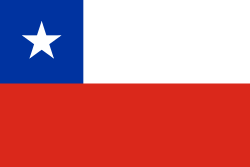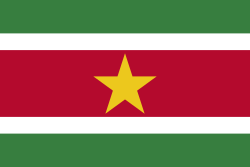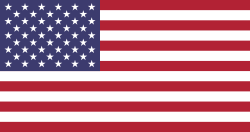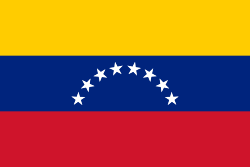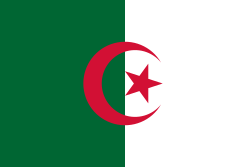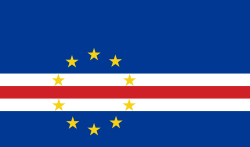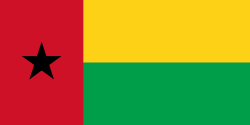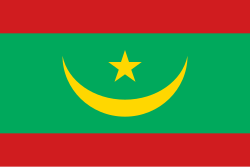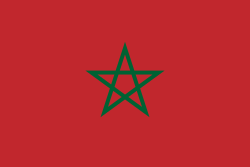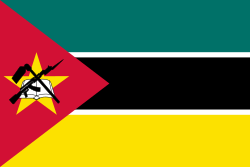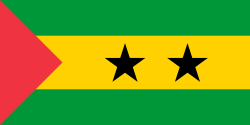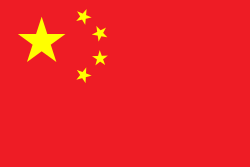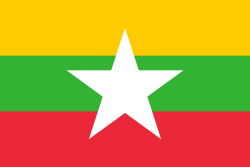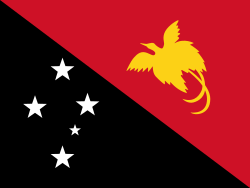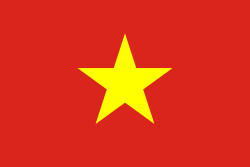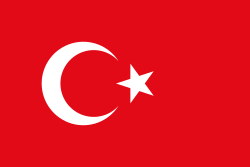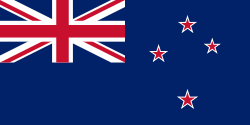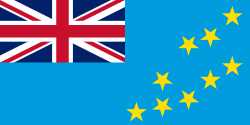Five-pointed star

A five-pointed star (☆), geometrically an equilateral concave decagon, is a common ideogram in modern culture. Comparatively rare in classical
It has also become a symbol of fame or "stardom" in Western culture, among other uses.
History of use
Early history
| |

The five-pointed star is the oldest symbol of Italy. Venus (once considered a star instead of a planet) represented the West and was, in Classical mythology, the symbol of the Italian peninsula, which was western to Greece.
The star (or
The star in the coat of arms of the
Modern flags and emblems
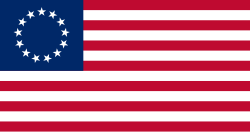
The five-pointed stars on the
Five-pointed stars became more frequently used in the 19th century. The
In 19th century the five-pointed star, which has always represented Italy, is on the copper cents coins of Vittorio Emanuele II king of Italy. Even today we find the five-pointed star in the emblem of the Italian Republic.
The five-pointed star also came to be widely used in military badges in the 19th century. A red star was used as the badge of
The U.S. tradition of barnstars, decorative five-pointed stars attached to buildings, appears to have arisen in Pennsylvania after the Civil War, and became widespread by the 1930s.[7]
The Swiss
The green five-pointed star used as a symbol of Esperanto was first proposed in 1890.
The five-pointed
In the
The Flag of Europe, designed in 1955 on behalf of the Council of Europe (CoE) and adopted by the European Communities in 1985 (and thus inherited as the flag of the European Union upon its creation in 1993) has a circle of twelve yellow (gold) stars on a blue (azure) field.[8]
Other uses in modern culture

The use of "star" for theatrical lead performers dates to 1824, giving rise to the concept of "stardom" in the film industry. The Hollywood Walk of Fame, where famous entertainers are honored with pink terrazzo five-pointed stars along Hollywood Boulevard, was introduced in 1958.[9]
In
Five-pointed stars may be used on elevators to indicate the ground level or lobby of a building.
They are also used on various police, fire, and paramedic badges.
Heraldry
The Stella d'Italia ("Star of Italy"), popularly known as Stellone d'Italia ("Great Star of Italy"),
In the early 16th century it began to be frequently associated with
The Italian Star is also recalled by some honors. The Italian Star is recalled by the Colonial Order of the Star of Italy, decoration of the Kingdom of Italy which was intended to celebrate the Italian Empire, as well as by the Order of the Star of Italian Solidarity, the first decoration established by Republican Italy, which was replaced in 2011 by the Order of the Star of Italy, second civil honorary title in importance of the Italian State.[16] The Star of Italy is also recalled by the stars worn on the collars of Italian military uniforms and appears on the figurehead of the Italian Navy. In the civil sphere, the Italian Star is the central symbol of the emblem of the Club Alpino Italiano.[17]
The symbolism of a star associated with Italy first appeared in the writings of the ancient Greek poet Stesicoro, from whom it passed on to poets such as Virgil. The oldest national symbol of Italy,[12] it originated from the combination of Venus, as an evening star, with the West[18] and therefore with the Italian peninsula, one of which was Esperia, or "land of Hesperus, the star of the Evening consecrated to Venus".[18][19] This symbolism was already attested in archaic Greek literature, in 6th century BC by the poet Stesichorus, in the poem Iliupersis (Fall of Troy) that created the legend of Aeneas which described his return to the land of his ancestors (Italy) after the defeat of Troy, under the leadership of Venus.[12]
Relation to the pentagram

As a symbol or emblem, the five-pointed star, or mullet of five points, arises from classical heraldry, and it shares none of the esoteric or occult associations given to the pentagram, or "Seal of Solomon", since at least the Renaissance period.
The two emblems are frequently associated, or identified, in contemporary
List of national flags
Americas
-
Brazil
-
Chile
-
Cuba
-
Dominica
-
Grenada
-
Honduras
-
Panama
-
Saint Kitts and Nevis
-
Suriname
-
United States
-
Venezuela
Africa
-
Algeria
-
Angola
-
Burkina Faso
-
Cameroon
-
Cape Verde
-
Central African Republic
-
Comoros
-
Djibouti
-
DR Congo
-
Ethiopia
-
Ghana
-
Guinea-Bissau
-
Liberia
-
Libya
-
Mauritania
-
Morocco
-
Mozambique
-
Sao Tome and Principe
-
Senegal
-
Somalia
-
South Sudan
-
Togo
-
Tunisia
-
Zimbabwe
Asia
-
China
-
Myanmar
-
North Korea
-
Pakistan
-
Papua New Guinea
-
Philippines
-
Samoa
-
Singapore
-
Solomon Islands
-
Syria
-
Tajikistan
-
Timor-Leste
-
Turkmenistan
-
Uzbekistan
-
Vietnam
-
Turkey
Australia and Oceania
-
Australia
-
Federated States of Micronesia
-
New Zealand
-
Papua New Guinea
-
Samoa
-
Solomon Islands
-
Tuvalu
Europe
-
Bosnia & Herzegovina
See also
- Arabic star
- List of symbols
- Nautical star
- Pentagram
- Red star, the international symbolism of socialism. Also used by United States pioneering military aircraft in early 1916
- Star (glyph)
- Star (heraldry)
- Star polygon
- Star polygons in art and culture
- Starfish
- Starfruit
- The Five Star Stories
- United States military aircraft national insignia, which have mostly used five-pointed stars since 1916
Unicode
Unicode provides various Five-pointed Star Symbol:[21][22]
| Symbol | Name | Code point |
|---|---|---|
| ٭ | Arabic five-pointed star[a] | U+066D |
| 🌟 | Glowing Star | U+1F31F |
| 🌠 | Shooting Star | U+1F320 |
| ⁎ | Low asterisk | U+204E |
| ≛ | Star Equals | U+225B |
| ⋆ | Star Operator | U+22C6 |
| ⍟ | APL functional Symbol Circle Star | U+235F |
| ⍣ | APL functional Symbol Star diaeresis | U+2363 |
| ★ | Black Star | U+2605 |
| ☆ | White Star | U+2606 |
| ☪ | star and crescent | U+262A |
| ⚝ | outlined white star | U+269D |
| ⛤ | Pentagram | U+26E4 |
| ⛥ | Right-Handed Interlaced Pentagram | U+26E5 |
| ⛦ | Left-Handed Interlaced Pentagram | U+26E6 |
| ⛧ | Inverted Pentagram | U+26E7 |
| ✩ | Stress Outlined White Star | U+2729 |
| ✪ | Circled White Star | U+272A |
| ✫ | Open Center Black Star | U+272B |
| ✬ | Black Center White Star | U+272C |
| ✭ | Outlined Black Star | U+272D |
| ✮ | Heavy Outlined Black Star | U+272E |
| ✯ | Pinwheel Star | U+272F |
| ✰ | Shadowed White Star | U+2730 |
| ⭐ | White Medium Star | U+2B50 |
| ⭑ | Black Small Star | U+2B51 |
| ⭒ | White Small Star | U+2B52 |
| * | Full Width Asterisk | U+FF0A |
| 🟉 | Light Five Pointed Black Star | U+1F7C9 |
| 🟊 | Heavy Five Pointed Black Star | U+1F7CA |
References
- ^ Arthur Charles Fox-Davies, A Complete Guide to Heraldry (1909), p. 296.
- ^ Brooke, Richard, "The Field of the Battle of Barnet" in Visits to Fields of Battle, in England, of the Fifteenth Century: To which are Added Some Miscellaneous Tracts and Papers Upon Archaeological Subjects (1857), p. 209.
- ^ Williams Jr., Earl P. (October 2012). "Did Francis Hopkinson Design Two Flags?" (PDF). NAVA News (216): 7–9. Retrieved 16 February 2017.
- ^ Lane, Megan (14 November 2011). "Five hidden messages in the American flag". BBC News. Retrieved 30 October 2013.
- ^ Cooper, Grace Rogers (1973). Thirteen-Star Flags. Washington, D.C.: Smithsonian Institution Press.
- ^ "Historic Wings - Flight Stories - Chasing Pancho Villa". fly.historicwings.com. HW. 15 March 2013. Retrieved 21 February 2016.
Just one day after arriving, on March 16, 1916, the first reconnaissance flight was flown by Capt. Dodd with Capt. Foulois (as an observer) on the Curtiss JN-3 S.C. No. 43. As with all of the Army's aircraft in that era, the plane carried simple markings – a red star on the tail and the large number 43 painted on the sides of the fuselage.
- ^ "Barn Stars in Bedford and Somerset Counties, Pennsylvania". www.thebarnjournal.org.
- ^ The EU inherited the flag's use when it was formed in 1993, being the successor organisation to the EC. It has been in wide official use by the EU since the 1990s, but it has never been given official status in any of the EU's treaties. Its adoption as an official symbol of the EU was planned as part of the proposed European Constitution, which failed to be ratified in 2005. Official Journal of the European Union, 2007 C 306–2, p. 267
- ^ "Hollywood Walk of Fame". WalkOfFame.com. Retrieved 13 July 2011.
- Fédération Internationale de Football Association. 7 February 2008. Archived from the originalon 15 December 2014. Retrieved 15 December 2014.
- ^ "Why Bayern Munich have only four stars on their shirt". talkSPORT. 11 March 2014. Retrieved 17 June 2016.
- ^ a b c d e Rossi 2014, p. 38.
- ^ "I simboli della Repubblica – L'emblema" (in Italian). Retrieved 2 February 2016.
- ^ a b Bazzano 2011, p. 7.
- ^ Bazzano 2011, p. 174.
- ^ "Relazione di accompagnamento del disegno di legge governativo" (PDF) (in Italian). Archived from the original (PDF) on 4 June 2015. Retrieved 2 February 2016.
- ^ "Le stellette" (in Italian). Retrieved 4 June 2017.
- ^ a b Bazzano 2011, p. 101.
- ^ Bazzano 2011, p. 12.
- ^ e.g. Flavio Barbiero, The Secret Society of Moses: The Mosaic Bloodline and a Conspiracy Spanning Three Millennia (2010), p. 345.
- ^ "Star symbol".
- ^ Geometric Shapes Extended Range: 1F780–1F7FF
Bibliography
- Bazzano, Nicoletta (2011). Donna Italia. L'allegoria della Penisola dall'antichità ai giorni nostri (in Italian). Angelo Colla Editore. ISBN 978-88-96817-06-3.
- Rossi, Girolamo (2014). Lo scudo crociato. Un simbolo medievale nella comunicazione politica del Novecento (in Italian). Armando Editore. ISBN 978-88-96817-06-3.


